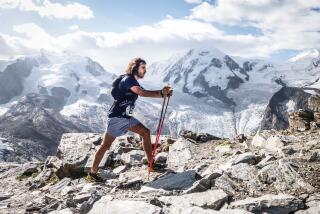RACE ACROSS AMERICA : Pushing Themselves to the Wheel Limit : Bicycling: Riders enter the cross-country competition to test their endurance and sanity.
ON THE ROAD TO SAVANNAH, Ga. — The man pulled up in a broken-down station wagon outside the Maverik Country Store in Flagstaff, Ariz.
Noticing a group of people in a gravel lot next door, he wandered over to see what was happening.
He seemed stunned when told that 45 bicycle riders were racing cross-country from Irvine to Savannah, Ga. And that any minute now they’d be passing through town.
“Are they drunk?” the man asked. “All the way across the United States of America? On bicycles?”
He shook his head and went into the store. Minutes later, he reappeared, shook his head again and drove away.
At a southern Colorado gas station 25 miles from Wolf Creek Pass, altitude 10,850 feet, the woman behind the counter wondered what so many people were doing up at 5:30 a.m.
When told they were watching a cross-country bicycle race that would soon be passing by, headed over Wolf Creek Pass, she was taken aback.
“You can’t ride a bike up there,” the woman said. “It’s hard enough driving a car over that pass.”
To many outside--and inside--racing circles, the concept of the Race Across America crosses the bounds of sanity.
Eight to 11 days of bicycle racing over a 2,922-mile route with only two to three hours of sleep each day defies reason. How does one rationalize the irrational?
Throw in the accompanying factors--temperatures that range from 118 degrees in the Mojave Desert to under 45 on mountain passes in southern Colorado, saddle sores and the tendency to hallucinate in the latter stages of the race--and the obvious observation comes forth.
These people are nuts.
And maybe that’s true, but 45 long-distance bicyclists, including six women, left Irvine Aug. 5 trying to prove that there are no limits to human endurance. At least none that can be contained by the nation’s borders.
This is the ninth Race Across America, and riders will cross the finish line in Savannah and live to ride another day. Others will not finish, but they will try again next year.
If this race seems warped, so be it. The RAAM riders know their pursuit crosses the boundaries of physical and mental endurance. Some seem to take perverse pride in riding past conventional wisdom, stretching their endurance threshold beyond that of most people. Hallucinations are at the same time disturbing and humorous to those in the RAAM.
A few years ago, one crew found its rider standing beside a railroad track, pawing at the rail with his foot.
“Why aren’t you on your bike?” someone said.
“I’ve been talking to God and He said I should take a train,” came the response.
The crew burst out laughing, then helped the rider into the support van for a nap.
Dave Tanner of Bloomington, Ind., weaved erratically up a hill during last year’s race. After a few minutes, his crew pulled alongside and asked Tanner why he was weaving.
“I don’t want to hit any of the frogs on the road,” Tanner said. “One just jumped through my spokes.”
The crew looked long and hard, but didn’t see a single frog on the road.
Still another crew watched its rider talking over his shoulder for almost 30 minutes. There was no one there.
In most cases, physical and emotional distress suffered in the RAAM is not permanent, according to Randy Ice, a physical therapist who has studied the effects of long-distance cycling on a number of riders.
“They all cope with it in different ways,” Ice said at a pre-race meeting Aug. 4 in Irvine.
Writing in the August edition of California Bicyclist magazine, Ice breaks the riders’ fatigue into four categories: cardiovascular, nutritional, muscle and neurological.
The four will not keep a rider from someday completing a 3,000-mile RAAM course in fewer than seven days, Ice writes.
Last month, Mike Secrest came close to proving him correct. Riding a 2,916-mile course from Huntington Beach to Atlantic City, N.J., in order to raise money for the Phoenix Symphony Orchestra, Secrest finished in 7 days 23 hours and 16 minutes. He broke Paul Solon’s RAAM record set last year by nearly 10 hours.
But the eternal question remains: Why do cyclists ride in the RAAM?
“They couldn’t tell you,” a member of Al Muldoon’s support crew said after a dinner break last Thursday night in Snyder, Tex. “It’s all very personal to them. They can’t express it.”
It’s true. Almost three weeks before the race, Jim Penseyres sat in the dining room of his home in San Juan Capistrano and struggled to put the reasons into words.
But he could not describe the uniqueness of the race or the people who ride in it, or the feeling of conquering the nation’s back roads. Penseyres, 43, is a bright man, a graduate of Cal State Long Beach, a machinist at the San Onofre nuclear plant and a two-time RAAM finisher. But he couldn’t describe his affection for the RAAM.
Matt Bond, 29, of Dayton, Ohio, faced a similar question before the race.
He also struggled to find the words. He spoke of his great physical fitness and what a shame it would be to waste it, so why not ride in the RAAM?
But somehow that didn’t seem quite right either. There’s got to be more to it than that.
Really, the questions of how and why are irrelevant. It’s like asking Magic Johnson how he could take an inbounds pass, rush past Dennis Johnson, pull up in front of the three-point line, jump off the wrong foot and bank in a three-pointer at the buzzer to beat the Boston Celtics in the Garden.
Magic couldn’t answer the question any better than Penseyres or Bond could tell you how or why they ride cross-country.
So let’s go with the simplest answer: RAAM is the next logical step for ultramarathon cyclists.
RAAM riders didn’t wake up one day and say, “I think I’ll ride 3,000 miles today.” Their endurance evolved.
All began riding shorter races, 50 or 100 miles. Most were successful, but saw that the distance was not fulfilling. So they moved up to 500-mile races or even 24-hour rides.
Some competed in the Ironman or Ultraman triathlons.
Not everyone is gifted enough to ride in the Tour de France. So what these riders lack in speed, they make up for in endurance.
Finally, there is nothing left on the long-distance schedule except the RAAM, contested every year since 1982. It was the next logical step and so they took it.
In almost every case, RAAM riders are highly-motivated, goal-oriented, college-educated professionals. They are used to attaining what they desire.
Temperment, according to a member of Muldoon’s support crew, is paramount. It takes a special person to stay focused and ride through the depression and giddy moments of a 10-day race. One’s mood swings wildly enough over the course of 10 days even without riding a bike 3,000 miles.
Only a few have a fitting psyche to compete in the RAAM. Those who do, ride. Those who don’t, don’t.
It’s simple. And, when you think about it, probably not all that crazy after all.
Times staff writer Steve Kresal contributed to this story.
FOURNEY EXTENDS LEAD
Despite a sore neck, Bob Fourney is leading the Race Across America by 1 1/2 hours. C14
More to Read
Sign up for Essential California
The most important California stories and recommendations in your inbox every morning.
You may occasionally receive promotional content from the Los Angeles Times.










